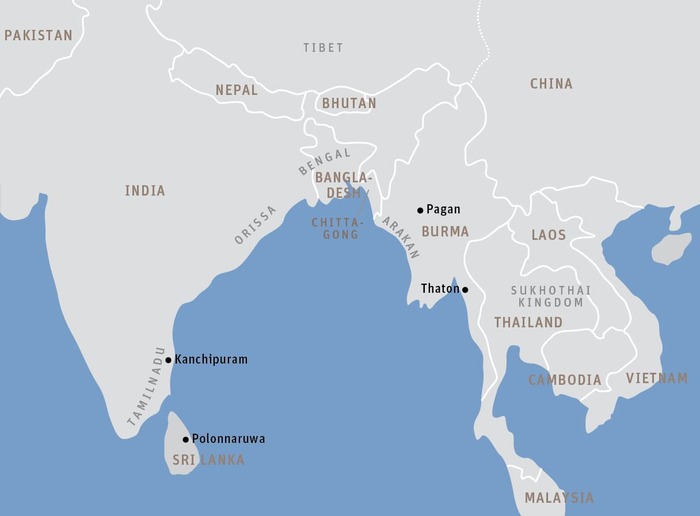
Buddhism first arrived in Sri Lanka in 249 BCE through the mission of the Indian Emperor Ashoka’s son, Mahinda. The first Sri Lankan bhikshus were ordained at that time. Although the date from which the name Theravada was used is in dispute, for the sake of simplicity we shall refer to this Buddhist lineage as “Theravada.” The Theravada bhikshuni ordination lineage was then transmitted to Sri Lanka in 240 BCE with the arrival of Emperor Ashoka’s daughter, Sanghamitta, to the island. By 1050 CE, this ordination lineage ended as a consequence of the Tamil invasion and subsequent rule of Sri Lanka under the Chola Empire.
According to oral tradition, Emperor Ashoka also sent two emissaries, Sona and Uttara, to the kingdom of Suwannaphum (Skt. Suvarnabhumi), and they established Theravada Buddhism and the bhikshu ordination lineage there. Most scholars identify this kingdom with the Mon (Tailaing) people and the port city of Thaton in southern Burma. It is unclear, however, whether the bhikshuni ordination lineage was transmitted at this time or later.
Although Theravada Buddhism was present in the various Pyu city states of Northern Burma from at least the 1st century BCE, it became mixed with Mahayana, Hinduism, and the local Ari religion, which involved animal sacrifices to spirits. In the mid-11th century CE, King Anawrahta unified northern Burma, conquered the Mon kingdom at Thaton, established his capital at Pagan, and invited the Mon bhikkhu Arahanta to establish Theravada Buddhism and its ordination lineages throughout his kingdom.
With the defeat of the Cholas in Sri Lanka in 1070 CE and the establishment of the new capital at Polonnaruwa, the Theravada bhikshu ordination lineage was re-established in Sri Lanka by bhikshus invited from Pagan. King Anawrahta, however, questioned the purity of the Mon bhikshuni lineage and, consequently, did not send any bhikshunis to re-establish the bhikshuni ordination. Thus, the Theravada ordination lineage of bhikshunis was not revived at that time in Sri Lanka. The last inscriptional evidence of the presence of a bhikshuni nunnery in Burma is in 1287 CE, when Pagan fell to the Mongol invasion.
Sri Lanka was invaded and most of it ruled, from 1215 to 1236 CE, by King Magha of Kalinga (modern-day Odisha, East India). During this period, the Sri Lankan bhikshu sangha was severely weakened. With the defeat of King Magha, Theravada bhikshus from Kanchipuram, a Buddhist center within the weakened Chola Kingdom in present-day Tamilnadu, South India, were invited to Sri Lanka in 1236 CE to revive the bhikshu ordination lineage. The fact that no Tamil bhikshunis were invited suggests that the Theravada bhikshuni sangha was no longer present in South India by this time. The last inscriptural evidence of a bhikshuni sangha in North India, including Bengal, is from the end of the 12th century CE. It is unclear which lineage of bhikshuni vow the nuns held.
King Ramkhamhaeng of the Sukhothai Kingdom in Thailand established Theravada Buddhism in Thailand from Sri Lanka at the end of the 13th century CE. Since a bhikshuni sangha was no longer available in Sri Lanka at that time, the Theravada bhikshuni ordination lineage never reached Thailand. Only the bhikshu lineage came. Since Theravada was established in Cambodia from Thailand in the early 14th century CE and, shortly thereafter, in Laos from Cambodia, the Theravada bhikshuni ordination lineage never reached these countries either.
In the Theravada countries, only Sri Lanka has officially re-established the Theravada bhikshuni ordination, and that was in 1998 CE. Up until then, women in Sri Lanka were only allowed to become dasasil matas, “ten-precept practitioners,” but not bhikkhunis. Although such laywomen wear robes and keep celibacy, they are not considered members of the monastic sangha. In Burma and Cambodia, women are allowed only to become “eight-precept practitioners,” known in Burma as silashin and in Cambodia as donchi or yieychi. Some women in Burma also receive the ten precepts. In Thailand, they may become “eight-precept practitioners,” known as maechi (maeji). Since the revival of Theravada Buddhism in the Chittagong District and the Chittagong Hill Tracts of Bangladesh in 1864 CE from the Arakan district of coastal Burma, women have become eight-precept practitioners there.